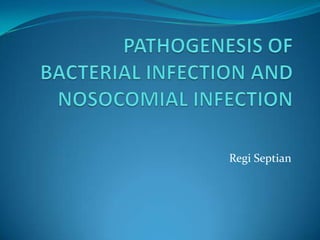
Pathogenesis of bacterial infection and nosocomial infection
- 1. Regi Septian
- 2. Introduction Infection Identification of microorganisms in host tissue or the blood stream, and an inflammatory response to their presence. Pathogenesis mechanism of infection and to the mechanism by which disease develops.
- 4. Host Defenses Host possesses several layers of endogenous defense mechanism prevent microbial invasion, limit proliferation of microbes within the host, and contain or eradicate invading microbes. Skin physical barrier. Mucus + cilia trapping and clearing respiratory tract Gastric acid kills bacteria Macrophages, complements, immunoglobulin inflammatory response activation
- 5. Host Defenses The magnitude of the response and eventual outcome generally are related to several factors: (a) the initial number of microbes (b) the rate of microbial proliferation in relation to containment and killing by host defenses (c) microbial virulence (d) the potency of host defenses. drugs or disease states that diminish any or multiple components of host defenses are associated with higher rates and potentially more grave infections.
- 6. Etiology Bacteria, Fungi, Virus Bacteria: Major etiology of surgical infections. Gram (+) aerobic skin commensals (Staphylococcus aureus and epidermidis and Streptococcus pyogenes) and enteric organisms such as E. faecalis and faecium Aerobic skin commensals cause a large percentage of surgical site infections Enterococci can cause nosocomial infections [urinary tract infections (UTIs) and bacteremia] in immunocompromised or chronically ill patients, but are of relatively low virulence in healthy individuals
- 7. Bacteria Gram (-) E. coli, Klebsiella pneumoniae, Serratia marcescens, and Enterobacter, Citrobacter, and Acinetobacter spp. Anaerobic organism unable to grow or divide poorly in air, as most do not possess the enzyme catalase, which allows for metabolism of reactive oxygen species.
- 8. Fungi Fungi of relevance to surgeons include those that cause nosocomial infections in surgical patients as part of polymicrobial infections or fungemia (e.g., C. albicans and related species), rare causes of aggressive soft tissue infections (e.g., Mucor, Rhizopus, and Absidia spp.), and so-called opportunistic pathogens that cause infection in the immunocompromised host (e.g., Aspergillus fumigatus, niger, terreus, and other spp., Blastomyces dermatitidis, Coccidioides immitis, and Cryptococcus neoformans).
- 9. Virus Most viral infections in surgical patients occur in the immunocompromised host, particularly those receiving immunosuppression to prevent rejection of a solid organ allograft. Relevant viruses include adenoviruses, cytomegalovirus, Epstein-Barr virus, herpes simplex virus, and varicella-zoster virus. Surgeons must be aware of the manifestations of hepatitis B and C virus, as well as HIV infections, including their capacity to be transmitted to health care workers
- 10. Nosocomial Infection Infections that are acquired in hospital (48 hours or more after admission) SSI (Surgical Site Infection) UTI (Urinary Tract Infection) Pneumonia Bacteremia
- 11. SSI (Surgical Site Infection) Infections of the tissues, organs, or spaces exposed by surgeons during performance of an invasive procedure Classification : Incisional Infections - Superficial - Deep Organ/Space infections
- 12. Factors related to SSI develoment : The degree of microbial contamination The duration of the procedure Host factors (diabetes, malnutrition, obesity, etc.)
- 13. UTI (Urinary Tract Infection) Prolonged use of folley catheter for purpose of urinary drainage Culture results : > 104 CFU/mL of microbes Postoperative surgical patients should have urinary catheters removed as quickly as possible, typically within 1 to 2 days, as long as they are mobile.
- 14. Hospital Acquired Pneumonia Prolonged use of ventilation tubes Diagnosis should be made using the presence of a purulent sputum, elevated leukocyte count, fever, and new chest x-ray abnormality Surgical patients should be weaned from mechanical ventilation as soon as feasible, based on oxygenation and inspiratory effort.
- 15. Bacteremia Prolonged use of venous or arterial access Many patients who develop intravascular catheter infections are asymptomatic, often exhibiting an elevation in the blood WBC count. Routine, scheduled catheter changes are associated with slightly lower rates of infection
- 16. 4 Important Factors The host The microbes The environment Treatment
- 17. The Host People in hospital are already sick Poor general resistance to infection Lack of immunity age, immunocompromised Reduced immunity diabetes, severe burns Poor local resistance poor blood supply to tissues Surgery wound, sutures Medical devices catheters, prostheses, tubing
- 18. The Microbes Nosocomial infections are often caused by opportunistic pathogens those which do not normally cause infection in healthy people May be a reflection of reduced defences of host or access to sites not normally colonised by organisms May be from normal flora or environment
- 19. Opportunistic Pathogens Pseudomonas aeruginosa Staphylococci E. coli and other coliforms Streptococci and Enterococci Bacteriodes fragilis Candida albicans Herpes simplex virus Cytomegalovirus
- 20. The Environment Own normal flora (endogenous) Infected patients Traffic of staff and visitors Blood products Surgical instruments
- 21. Prevention and Treatment Prophylaxis Maneuvers to diminish the presence of exogenous (surgeon and operating room environment) and endogenous (patient) microbes General Principles: Minimalize microflora entering the surgical site: Gloves, gown Aseptic and antiseptic Hair removal before the procedure
- 22. Source Control The primary precept of surgical infectious disease therapy consists of drainage of all purulent material, débridement of all infected, devitalized tissue, and debris, and/or removal of foreign bodies at the site of infection, plus remediation of the underlying cause of infection An ongoing source of contamination (e.g., bowel perforation) or the presence of an aggressive, rapidly- spreading infection (e.g., necrotizing soft tissue infection) invariably requires expedient, aggressive operative intervention, both to remove contaminated material and infected tissue (e.g., radical débridement or amputation) and to remove the initial cause of infection (e.g., bowel resection).
- 23. 5 Pillars of Infection Control Isolation and barrier precautions Decontamination of equipment Prudent use of antibiotics Hand washing Decontamination of environment
- 24. Thank You
- 25. Harap menambahkan tentang agent infeksi: flora normal, penghasil toksin, etc Perbedaan kolonisasi dan infeksi Infeksi jamur: dermatophyte? Saprophyte? Mukor?
